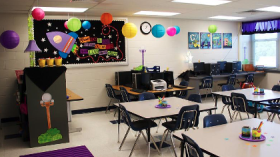
Keeping schools safe over winter
Winter months pose a number of additional dangers to both pupils and school staff. RoSPA’s Nathan Davies offers advice on how to tackle them with a ‘risk aware’ attitude.
As the summer weather begins to fade to make way for winter months, the important role that safety plays in schools and colleges will become ever more apparent.
Months before the autumn leaves fall, many schools will have devised a winter safety plan in order to safeguard the young people in their care.
After all, ensuring students and staff safety has been part of the ethical framework for decades and schools also have legal responsibilities for safety as an integral part of the Ofsted framework.
In order to keep children safe during the winter months, schools need to be prepared for adverse weather conditions, such as heavy rain, flooding and cold temperatures.
School winter safety arrangements need to be implemented now. These arrangements should be designed to protect everyone on school property from injury, and help to prevent potentially unsafe situations being allowed to occur on and off site.
Have a plan
So, how do schools ensure their pupils are safe during the cold snap? Well, first of all they need to have a functional plan of what is needed to make the school safe.
As you may know, schools have a legal duty to carry out ‘suitable and sufficient’ risk assessments. The risk assessment should detail the foreseeable risks that are significant and that are associated with the schools facilities or activities. The main element of the assessment is to make provision for the precautions needed to minimise the risks identified. There is no need to document each and every hazard that exists, but you should think about the likelihood and effects of, ice, snow, excessive water and high winds, and the effect of these, e.g. tree and branch falls, excessive leaf fall in walkways and damage to buildings. More unusual hazards can exist, such as ice and snow sliding from pitched roofs that are poorly insulated, or roof collapses on poorly constructed or maintained structures. Only local knowledge and a keen eye can decide if this is a real issue for you.
With every winter comes the chance of snow and ice, therefore headteachers need to be sensitive to the dangers winter weather can pose to children and most importantly they need to be prepared to prevent significant problems arising and to have arrangements to deal with periods of extreme weather, when it is unacceptable for normal activities to continue.
Know the risks
We encourage school leaders and assessors to consider the real risks; is it appropriate for a school to close due to 75mm of snow on the playground, when all teaching staff and parents know full well that 80 per cent of the pupils will take the day free to go sledging and snowballing while carers will have to take an enforced days leave of work, or other planned activities? While everyone may enjoy the seasonal, unplanned break, fear of litigation or prosecution shouldn’t be used as the cause without very good reasons.
So, to prevent accidents from happening during icy conditions, it is essential that schools stock up on salt or grit and arrange for preventative gritting and clearance prior to prevent ice and snow settling, rather than relying on post ‘fall’ gritting and clearance, which is much less effective.
Preventative work needs to be a priority when frost, ice and snow are forecast, when walkways are likely to be damp or wet, or the ground temperatures are at or below freezing.
Be risk aware
RoSPA encourages children to get outside and to enjoy the wintry weather, wrapping up well to keep warm and dry. Therefore, if conditions are not too dangerous, there is nothing to stop children from playing outside, so long as there is plenty of supervision. But we do advise that a consistent approach is taken to deciding when it is appropriate not to allow play externally and when out of school activities should be rearranged or curtailed.
Reminding children and carers that additional cold weather sports equipment is required is always useful to ensure that exercise can be conducted as planned. This is because it is important for schools to help pupils become more ‘risk aware’ as opposed to ‘risk averse’ and equip them with the skills and knowledge they need to keep themselves and others safe. Nevertheless perhaps a short assembly session on not playing on ice might be prudent.
As an employer, schools should treat risk assessment and risk management as important tools to enable children to undertake activities safely but ‘health and safety’ should not be used as an excuse to cancel activities that can be conducted perfectly safely with a bit of pre planning.
All of these things can leave headteachers with a difficult decision on their hands – whether or not to close due to the weather. Headteachers should arrange for consultation about potentially contentious issues with those affected e.g. teachers, student representatives, the PTA, sports teachers and the maintenance staff. This will give all parties confidence that the right approach is being taken.
All in all, schools have a statutory duty to take all reasonably practicable steps to ensure the safety of pupils and staff on school premises. However, it is also vital to share with pupils the skills of recognising hazards, assessing risks and taking steps to control risks. Otherwise we all run the risk of promoting a culture where fear of litigation and criticism restricts learning, growth and enjoyment.
Further information
www.rospa.com/schoolandcollegesafety
Latest News
12/12/2025 - 11:39
The government has announced at least £3 billion to create tens of thousands of new speci
12/12/2025 - 07:07
The findings suggest that children and young people attending schools in the North of England are less likely to take part in and benefit from residential visits.
11/12/2025 - 13:52
Ofqual has launched a 12-week public consultation on its proposed approach to regulating on-screen exams in GCSEs, AS and A levels.
11/12/2025 - 09:49
A report by Ofsted and the Care Quality Commission (CQC) finds that support for children with special educational needs and/or disabilities (SEND) who do not attend school full-time is too inconsistent.
11/12/2025 - 09:37
The easy-to-use web-based tool is designed to help schools estimate how an air filter unit could impact air quality and energy consumption in a classroom.







